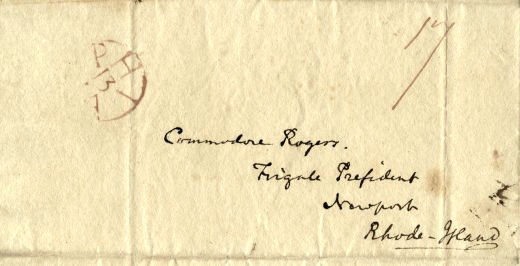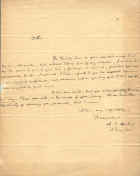![]()
Postal History Introduction
Stampless
Covers
1846
to 1900 Issues
1901-1950
Issues
1951-2003
Issues
Cancels
&
Miscellaneous
Postal
Stationery
Post
Cards
Air
Mail
First
Day &
Event Covers
Parcel Post/Special Delivery
Registered & Official Mail
Commercial & Advertising
Revenue & Postage Due
Wildlife & Game Issues
Complete List of RI Issues
|
Rhode Island Stampless
Covers & Letters |
||
|
||
|
This Stampless Folded Letter (SFL) was sent from Philadelphia, Pennsylvania by Alexander J. Dallas (Secretary of the Treasury 1814 to 1816) on January 13, 1812 to Commodore John Rogers on the Frigate USS President in port at Newport, Rhode Island. The brown Philadelphia CDS was used from 1798 to 1816 and again from 1823 to 1825. There is also a brown rate script 17 indicating that 17 cents was due from the recipient. This rate was set by the Postal Act of March 2, 1799, (effective on the same date) for mail traveling a distance of 150 to 300 miles. Mr. Dallas is requesting that Commodore Rogers grant a furlough for his son, so that he can be with the family in Philadelphia. He also indicates in the letter that he has heard the ship will be visiting Philadelphian in the near future and offers an invitation to the Commodore to visit. |
||
|
During the time this letter was written,
A. J. Dallas was serving as the District Attorney
for the Eastern District of Pennsylvania having
received this appointment from President Thomas Jefferson.
He held this office from 1801 to 1814.
After his appointment as Secretary of the Treasury
in 1814, he was entitled to the "Free
Franking" privilege. SEE: 1816 - A. J. Dallas - Free Franked Circular sent to Bank of Warren, Rhode Island |
||
|
In 1836 the letter was given to J. A. Foster by William Pinkney Rogers, the son of Commodore Rogers and inscribed by Foster as shown at the left. |
|
|
Alexander J. Dallas Alexander became a member of the bar in 1785 and began the practice of law a few years later. He was very successful lawyer and in 1791 he was appointed Secretary of State for Pennsylvania. During this time he was also a prolific writer for periodicals and was also the editor of "Columbian Magazine." He also compiled and wrote a four volume collection of law entitled, "Reports of Cases ruled and adjudged by the Courts of the United States and of Pennsylvania, before and since the Revolution." In 1801,in return for his support, President Thomas Jefferson appointed Dallas as the Attorney General for the Eastern District of Pennsylvania, which office he held until 1814. President James Madison appointed Alexander J. Dallas as Secretary of the Treasury in 1814. When he began his term the finances of the country were in shambles and Dallas recommended in a brilliantly written report that the required funds could not be raised by taxation alone and should be raised by the process government loans. In this respect, he also proposed the establishment of a National Bank. On April 3, 1815 the Act to establish a National Bank was passed by congress and signed into law by President Madison. Beginning in March 1815, Secretary Dallas also assumed the duties of Secretary of War and supervised the reduction of the army after the restoration of peace between the United States and Great Britain. He returned to the practice of law in November 1816, but died only a few weeks later in Trenton, New Jersey on January 14, 1817. Alexander's son Alexander James Dallas, Jr. was born in Philadelphia, Pennsylvania in 1791. He died on board his ship in Callao Bay, Peru in 1844. He married Arabella Smith in 1808 (died in childbirth) and then married Henrietta Meade and lastly Mary Byrd Willis in 1836. One of Alexander's other son's George Mifflin Dallas served as Vice-President of the United States under James K. Polk. Commodore John Rogers John Rogers was born in Harford, Maryland on July 11, 1771. He was the eighth of ten children born to Colonel John T. and Elizabeth Reynolds Rogers. He married Minerva Dennison (1784-1877) in 1806 and they had eleven children. He died at the Naval Asylum in Philadelphia, Pennsylvania on August 1, 1838. Commodore Rogers entered the Navy as a midshipman in 1798 and served as First Lieutenant on the maiden voyage of the USS Constellation. During the War of 1812 he was a proponent of using two large squadrons, one in American Waters and the other in British waters. The Secretary of the Navy, Paul Hamilton acting on Rogers advice placed Commodore Rogers in command of the squadron, which was to operate in British waters. The squadron consisting of the frigates, United States, Congress, President, sloop Hornet and brig Argus set sail on June 20, 1812; its primary mission to intercept a large convoy of British ships departing Jamaica for England. Shortly after setting sail Commodore Rogers sighted the British frigate Belvidera and gave chase. The USS President, (Rogers' flagship) closed the British frigate on June 23, 1812 and fired the first shot of the War of 1812. Subsequently, a gun exploded aboard President and the British vessel escaped into Halifax. Rogers then turned south to intercept the Jamaica fleet, but never caught up with them. Rogers' squadron then cruised between the south coast of France and the Canary Islands hoping to take some prizes in those waters, however he encountered mostly empty seas and returned home with nothing to show for his cruise. As a result of this unsuccessful cruise, the United States Navy made the decision to use their resources in single ship engagements and in commerce raiding. Near the end of the war The USS President under the command of Stephen Decatur, engaged HMS Endymion with HMS Pomone and HMS Tenedos arriving near the end of the battle. Outgunned and with over 50 of his crew dead or wounded Decatur surrendered and the President was taken to Bermuda as a prize of war. The frigate, USS President was authorized by Congress in 1794. Her keel was laid in 1795. Construction was halted after peace was established with the Barbary Pirates and begun again 1798. She was launched and commissioned in 1800. She put the sea for her first cruise under Commander Thomas Truxton and later in 1801 as the flagship of Commodore Richard Dale's Squadron to the Mediterranean. She returned to the Mediterranean again in 1804 and was placed in ordinary on her return to the United States in 1805. She was reactivated in 1809. NOTE: "Placed in Ordinary" meant that a ship was laid up along-side a dock and that the ship's masts, rigging, sails and guns had been removed and stored ashore. The Complete Text of
the Letter Follows Below: Dear
Sir, |
||

RI Historical
Society
Introduction
Stampless I
Stampless II
Stampless III
Stampless IV
Stampless V
Stampless VI
Brown & Ives Letters
The Hazard Family Letters
Joseph Tillinghast
Free Franked Letters
DeWolf Family Letters
Recently Added Pages


